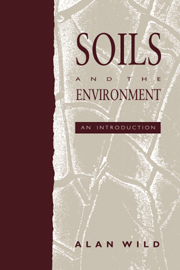Book contents
- Frontmatter
- Contents
- Preface
- Acknowledgements
- Units, symbols and general information
- 1 Introduction: soil in a natural and man-made environment
- A Soil properties and processes
- B Soils in relation to the environment
- 7 Soil as a medium for plant growth
- 8 Soil conditions and crop production
- 9 Soil acidification
- 10 Heavy metals and radionuclides in soil
- 11 Soils, the atmosphere, global warming and ozone depletion
- 12 Soil erosion and conservation
- 13 Soils in the environment: problems and solutions
- Suggestions for further reading
- Index
7 - Soil as a medium for plant growth
Published online by Cambridge University Press: 06 January 2010
- Frontmatter
- Contents
- Preface
- Acknowledgements
- Units, symbols and general information
- 1 Introduction: soil in a natural and man-made environment
- A Soil properties and processes
- B Soils in relation to the environment
- 7 Soil as a medium for plant growth
- 8 Soil conditions and crop production
- 9 Soil acidification
- 10 Heavy metals and radionuclides in soil
- 11 Soils, the atmosphere, global warming and ozone depletion
- 12 Soil erosion and conservation
- 13 Soils in the environment: problems and solutions
- Suggestions for further reading
- Index
Summary
Introduction
Although plants can be grown to maturity in aerated nutrient solutions and other media, virtually all land plants, including those on which we depend for food, fibre and fuel, grow in soil. The following requirements of plants can be met by soil:
anchorage for roots;
supply of water;
supply of air and particularly oxygen;
supply of mineral nutrients;
buffering against adverse changes of temperature and pH.
Soils rarely provide ideal conditions for plant growth. For the growth of crops, soil properties are usually changed in order to ensure good yields, most crop plants having been selected and bred for high production in fertile soil. In contrast, wild plants are adapted to the local conditions, including the climate, and possibly to low supplies of water, oxygen and nutrients, extreme pH, waterlogging, high concentrations of toxic elements, competition from other species or little anchorage.
In this chapter the emphasis is on principles, illustrated mainly by reference to crop plants, which have been more intensively studied than wild plants. For readers not familiar with the subject, the first section is an outline of the development and growth of plants. This is followed by accounts of the supply of water and nutrients to plant roots.
Plant development and growth
Seed and seedlings
The seed is the source of genetic material from which the plant develops. It consists of an embryo and a store of food reserves including carbohydrates, lipids, proteins and inorganic nutrients, enclosed in a protective coat. Its water content may be as low as 5% by mass.
- Type
- Chapter
- Information
- Soils and the Environment , pp. 109 - 136Publisher: Cambridge University PressPrint publication year: 1993



